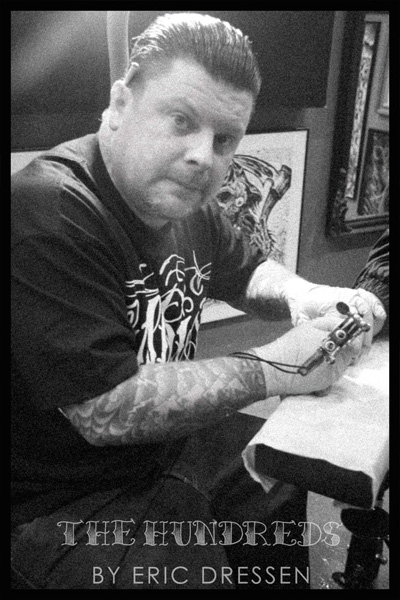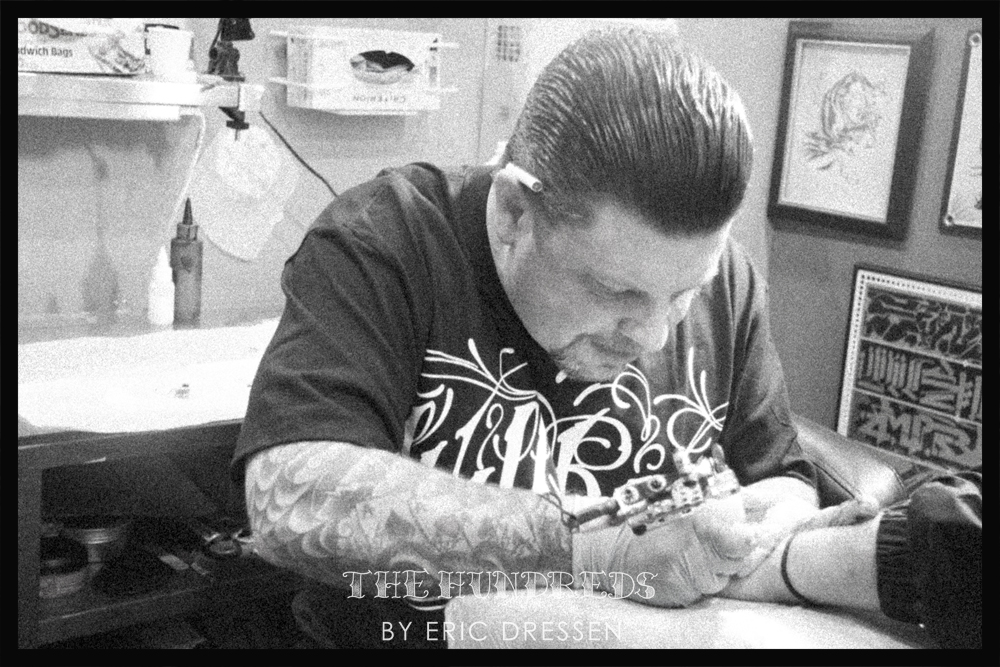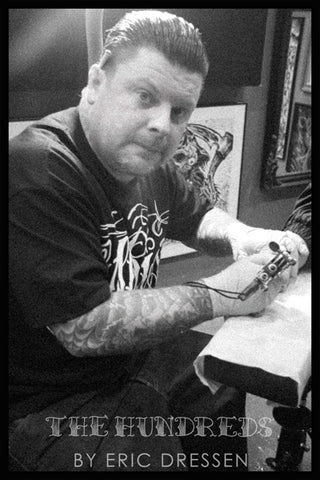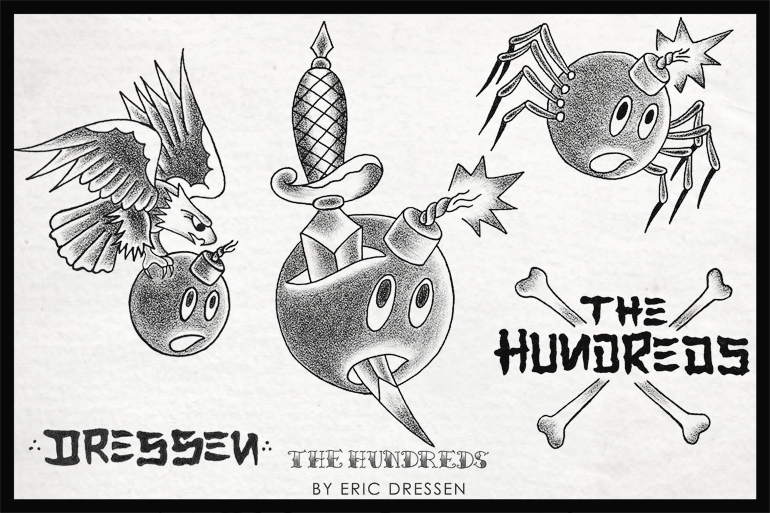Notes On A Venice Beach Original
An Interview With Veteran Professional Skateboarder Eric Dressen
Words by Cullen Poythress
Photos by Natalia Brutalia
There’s a near sublime mystique surrounding the nascent days of Southern California’s Venice Beach. It’s an idyllic portrait, now ubiquitous in popular culture, that the Venice boardwalk during the 70s and 80s was a hot cauldron of skateboarding, surfing, fashion, art and music oozing and bubbling at the brim with a progressive style and swag never before seen. It was a neon world of sunshine, backyard pools sessions, a burgeoning punk scene, hot beach babes and a new breed of hardcore skateboarders bent on partying and mayhem. Stoked in the public consciouses by early skate films like Thrashin’ and more recently, Lords Of Dogtown, life on Venice Beach truly was, according to many who lived it, a definitive hub for Southern California’s then newest cultural export”€skateboarding. Few know this better than Venice Beach local and original Dogtowner, Eric Dressen.
For anyone who’s come anywhere near skateboarding over the last thirty years, Eric Dressen is a household name. He grew up on the streets of Venice where he cut his teeth on what would become one of the most pioneering and enduring careers in professional skateboarding. During the 80s and 90s he helped define the now iconic images of some of the most recognized skateboard companies of all time including Alva Skates, Dogtown Skateboards and Santa Cruz Skateboards. His fast lines and aggressive approach to the street skating seen in early Santa Cruz films like Speed Freaks, Risk It and Troops Of Tomorrow firmly cemented his reputation during the latter part of the twentieth century as one of skateboarding’s original all terrain killers.
Today, at age 44, Dressen spends most of his waking hours honing his craft as a professional tattoo artist at Will Rise Studio on Fairfax Avenue in Los Angeles. There he enjoys front row seats to the ultra-dynamic, youth culture depot Fairfax Village has become. Reflecting back on his 33 year career as a professional skateboarder, he describes life on Fairfax as being very similar to the early days of Venice “€a tight knit community of highly creative people, working together, making things happen and forging bold new ideas for the future.
What are your earliest memories of growing up in Southern California?
I’m from Venice Beach. I grew up skateboarding, surfing and hanging out around hot rods and low riders. I’ve been reading the graffiti on the walls since I was a little ass kid. I’m 44 years old now. It goes back so far. The first time I ever seen anyone skateboard I was probably around five years old. My dad’s buddies got skateboards and they were all skateboarding, going down hills and carving. The first time I saw that, I knew that’s what I wanted to do. I wanted to be good at skateboarding. On my mom’s side of the family, everyone surfed and skated. My cousins always had skateboards. That’s how I got started at first.
What about growing up in Venice specifically? What was it like back then?
When I was a little kid growing up, the first skateboard magazines I ever saw had photos of guys like Tony Alva, Jay Adams and all the Z-Boys in Santa Monica. I related to them. I wanted to be like them. I wanted to be a Dogtown skateboarder. When I was 11, I moved to that side of the town and got on Alva. I knew everyone already, but I was still so young.
My dad’s buddies got skateboards and they were all skateboarding, going down hills and carving. The first time I saw that, I knew that’s what I wanted to do.

What was it like looking up to all those guys and then getting the opportunity to ride for Alva Skates?
It was gnarly. It was such a gnarly era back then. The summer of ’78 was so rad. Tony Alva had just come out with a big interview in Skateboarder Magazine. He had just came out with Alva Skates and Dog Town had just came out with their company. It was such a bitchin’ time back then. Sneaking into pools. Skating [school yards] Paul Revere and Kenter. Every day was epic. You’d run into people and skate rad spots. Everyone was kind of rough and tough back then. You’d leave the house and not know if you were going to get beat up or if someone was going to try to steal your skateboard. It was fun though, ya know. Looking back. It’s definitely different nowadays.
Who were some of the people you were skating with back then and what were the early-to-mid 80s like?
I got on Alva in the summer of ’78, but around 1980 skateboarding just died. The magazines went out of business and skateboard companies went out of business. I was kind of lost for a little bit there. I kind of stopped skateboarding. I tried surfing, started riding bicycles and got into going to the nightclubs in high school. Then one of my friends had a skateboard and we were skating some pools and quarter pipes and I was like, “This is my first love”. So I got back into it and got myself a skateboard. Around that same time skateboarding was making a comeback. In ’84 and ’85 street skating was just coming in. I started running into all my old friends like Tony Alva and everybody. This was right around when they were making the movie, Thrashin’. Tony took me to try out for Thrashin’. That’s where I met Natas and Jesse Martinez. That’s when I started hanging out down in Venice. I met Kelly Jackson. He was one of the first team riders on Dogtown when the company started up again. There were no skateparks or ramps back then. You’d just go meet down at the beach. That was the place to be. If you wanted to go skate with someone you’d have to go down there because there were so few skateboarders. There was always something happening down there, something to look at or something to get into.
How did the LA scene shape your attitude growing up?
I always had a lot of respect for my elders when I was growing up. I always learned a lot from them. I watched my back a lot. I never got in any trouble really or had many problems growing up. You just knew how to act right. If you didn’t know how to act you didn’t get to hang out.
Skateboarding didn’t come easy for me, but at a certain point it was. With tattooing you’ve got to work at it.
At what point did you make the jump to Santa Cruz? What prompted that transition after so much history riding for Southern California companies?
I was riding for Dogtown from ’86 to ’89. My career was taking off and I was winning contests. I kept getting the offer to ride for Santa Cruz. I went up there and they had this huge warehouse. They were like, “Here’s where your boards will be shipping out of.” And I was like, “Okay.” It was a big move for me. Being on Dogtown back then was kind like being on the Bad News Bears. We were the underdogs all the time. I felt like I had to move on. Plus, I wanted to be on a team with Jason Jesse. He was one of my favorite skateboarders. That was around ’89.
What was it about Jason Jesse that you liked so much?
I would just hear stories about him at first when he was just an amateur. Everyone would always talk about what a badass vert skater he was. The first time I ever saw him skate was in ’87 at the Arizona Wavepool contest. I seen him do the biggest backside air to fakie. It was so gnarly, just so high out. He came up to me and asked me if the guys on Dogtown were cool in a sarcastic kind of way. I was like, “Yea”. That was the first time I ever met him. I just like him a lot. I always thought he was a funny dude. He was the first guy I ever knew that had tattoos. I was like, “Whoa, you’ve got a tattoo on your arm. That’s going to be there forever.”
 Was it uncommon for skaters to have tattoos at that time?
Was it uncommon for skaters to have tattoos at that time?
He was the only guy I knew that had tattoos. During the summer of ’90 we went on this trip to Europe. Jason was on the trip and the whole time I remember being mesmerized by his arms. He had a portrait of Jesus and praying hands. I couldn’t believe it. It was so badass. He was telling me stories about [tattoo artists] Mark Mahoney and Danny Romo. It just seemed like this underground society, this little scene that always sounded so cool to me. I wanted to meet these guys, these old school, veterano, cholo-style tattooers. When I got home I went to get my first tattoo.
What did you get?
I went and got my name. I bit Jason Jesse’s stuff. He got Jesse on his arm, so I got Dressen. Then I started getting them here and there. Somewhere around 1999 I went on a crazy bender and started getting tattoos almost everyday.
At what point did you decide to start tattooing people?
I never really set out for it. All the top tattoo guys I met growing up skateboarding were hooking me up with tattoos. I started hanging out at my friend’s shop every day of the week and would be there just hanging out and trying to figure out what to get next. I just tried to pick up on what was going on. One day I started helping customers. I used to work at skate shops so I applied that same thing to selling tattoos. I was setting up, cleaning up, sterilizing and prepping needles. After that I got somewhat of an apprenticeship. I didn’t know how to draw or anything. I just knew what I liked. I learned how to draw from the bottom up. Pretty much everything was from the bottom up.
What styles of art do you appreciate? How does that influence your tattoo work?
I grew up looking at graffiti”€regular gang graffiti, rock-n-roll stuff and skate graffiti. We’d go skate a ditch and there would be stuff like, “Van Halen Rules”. I grew up looking at the walls. Whenever I got to go to Santa Monica as a little kid, I’d look for Santa Monica gangster graffiti. I always associated that stuff with the Dogtown graphics that Wes Humpston did. When I was a little kid in 4th grade I was drawing Dogtown crosses and trying to do gangster letters. I always saw art and had artists around me. Even though I didn’t draw, I knew what I liked.
What style of tattoo work do you typically do? What do people usually ask for?
I do a lot of skate tattoos. I’ve done a gang of, “Skate And Destroy”. I also do a lot of traditional style tattoos like Sailor Jerry stuff. A lot of stuff off the walls.Tattooing is really hard. I’ve been doing it for eight years and it’s still really tough. Skateboarding didn’t come easy for me, but at a certain point it was. With tattooing you’ve got to work at it. As soon as you think you’re good at it, something will happen and you know you’re not that good at it. It’s something you’ve got to dedicate time and energy to.
Are there certain artists out there who’s work inspires you?
My earliest inspiration was Wes Humpston. Growing up around all the Dogtown graphics his stuff really inspired me. Lettering is my favorite thing. I wanted to master lettering. But right now, it’s guys like RETNA and REVOK and all the MSK graffiti guys. The guys I’m around here at the shop. As far as tattooing, I like the older guys like Sailor Jerry, Ben Grillo and Norm. Being around Norm is so inspiring. Everyday he outdoes himself.
What’s it like working on Fairfax and having the opportunity to work around so many influential people and brands?
I love it. I’d always come to Supreme to come skate the bowl and would always run into people. Everyone around here is making shit happen. All the dudes at Supreme are making shit happen, all the dudes at Diamond are making shit happen and all the dudes at The Hundreds are making shit happen. Everyone is creative. Everyone that works in these stores are making music, or are into photography or they’re artists. Everyone’s a skateboarder around here. It’s like a family community. It kind of reminds me of Venice back in the day where you’d be skating down the street and bump into all your friends. You can’t help but bump into somebody at any time of day. It’s cool like that.


